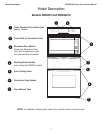
SEM/SEMW Oven Care and Use Manual
9
Heating Modes Available in Each Oven
Oven Features
The following illustrations give an overview of what happens in the oven with each mode
setting. The arrows represent the location of the heat source during specific modes. The
lower element is concealed under the oven bottom.
CONVECTION BROIL
Convection broiling
combines the
intense heat from the upper
element with the circulation
assisted by the convection fan.
This air circulation crisps the
exterior surface and retains inner
moisture in meats more than 1
-1
/
2" thick.
CONVECTION ROAST
Convection roasting
combines
the heat from the lower concealed
element with additional heat from
the convection element and fan.
The result is a crispier exterior that
seals in the interior juices.
It is
perfect for roasting tender meats
in an uncovered, low-sided pan.
CONVECTION BAKE
Convection Bake
has heat from
the upper and lower element with
circulation assisted by the convec-
tion fan. This mode is designed for
breads and pastries.
CONVECTION or
DEHYDRATE
Convection
cooking uses heat
from a third element concealed
behind the back wall of the oven.
It also uses a fan to speed up the
circulation of heated air through-
out the oven.
Dehydrate
is simi-
lar to convection cooking and
holds an optimum low temperature
while circulating the heated air to
remove moisture slowly for food
preservation.
BROIL
Broiling
uses intense heat radi-
ated from the upper element to
give excellent top browning or
searing.
ROAST
Roast
has more top heat than
bake. This additional top heat is for
conventional open roasting when
drippings are desired or for cov-
ered-dish roasting.
BAKE, PROOF or WARM
Baking is cooking with heated air.
Both upper and lower elements
are used to heat the air and cycle
to maintain the temperature.
Proofing,
while similar to baking,
holds an optimum low tempera-
ture for yeast to rise.
Warm mode
uses bottom heat to keep foods
at optimum warm tenperature.


















